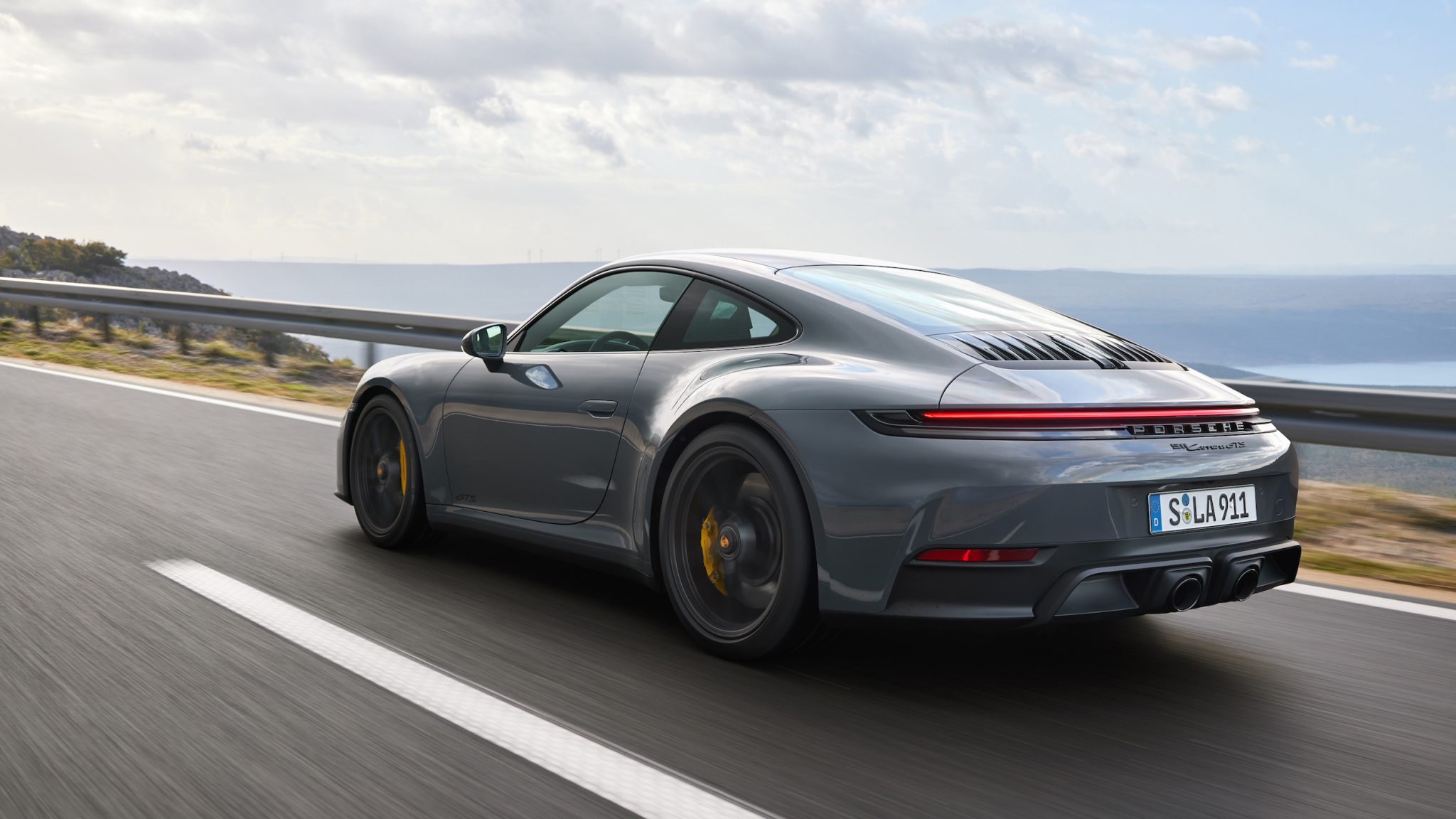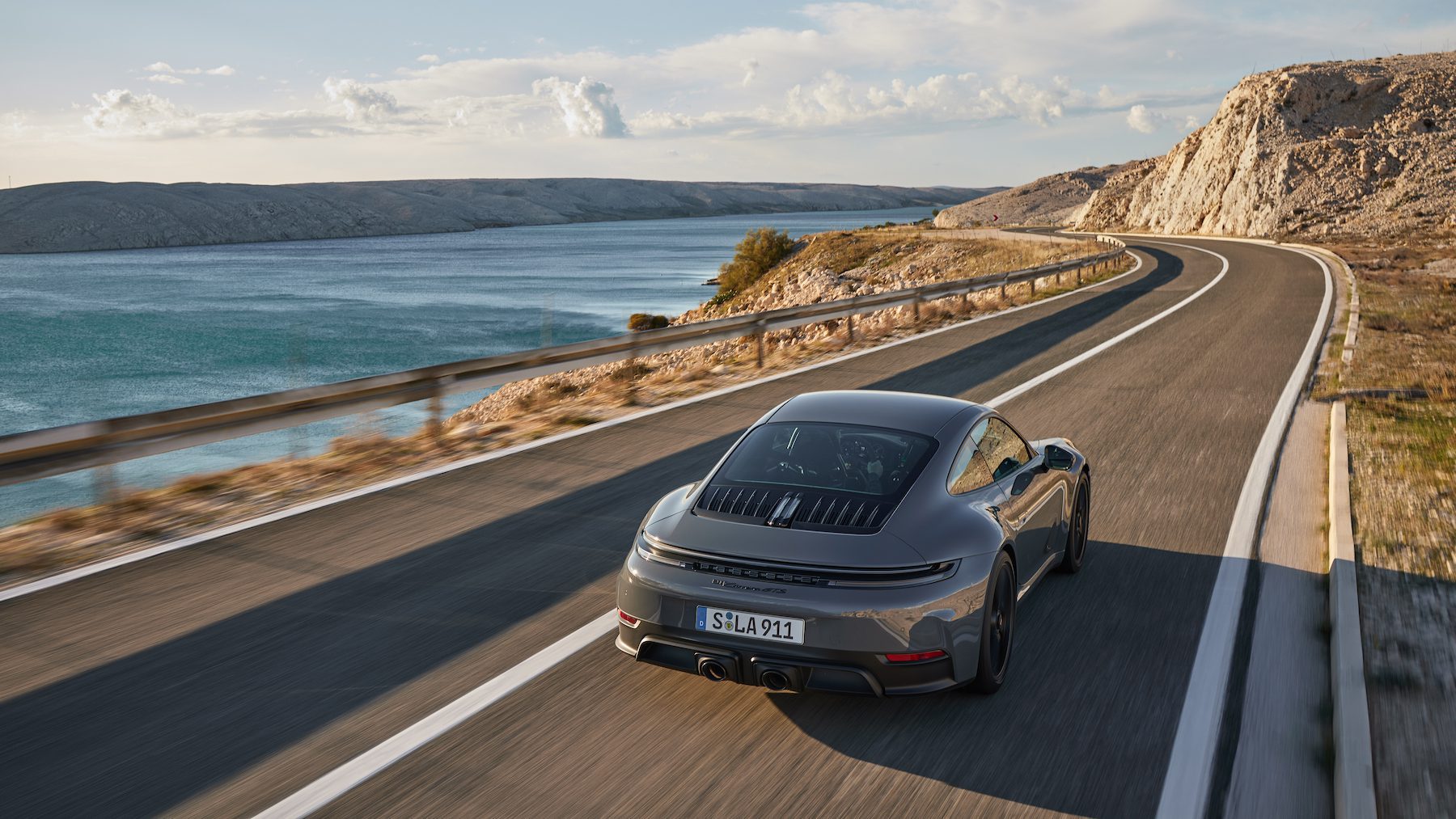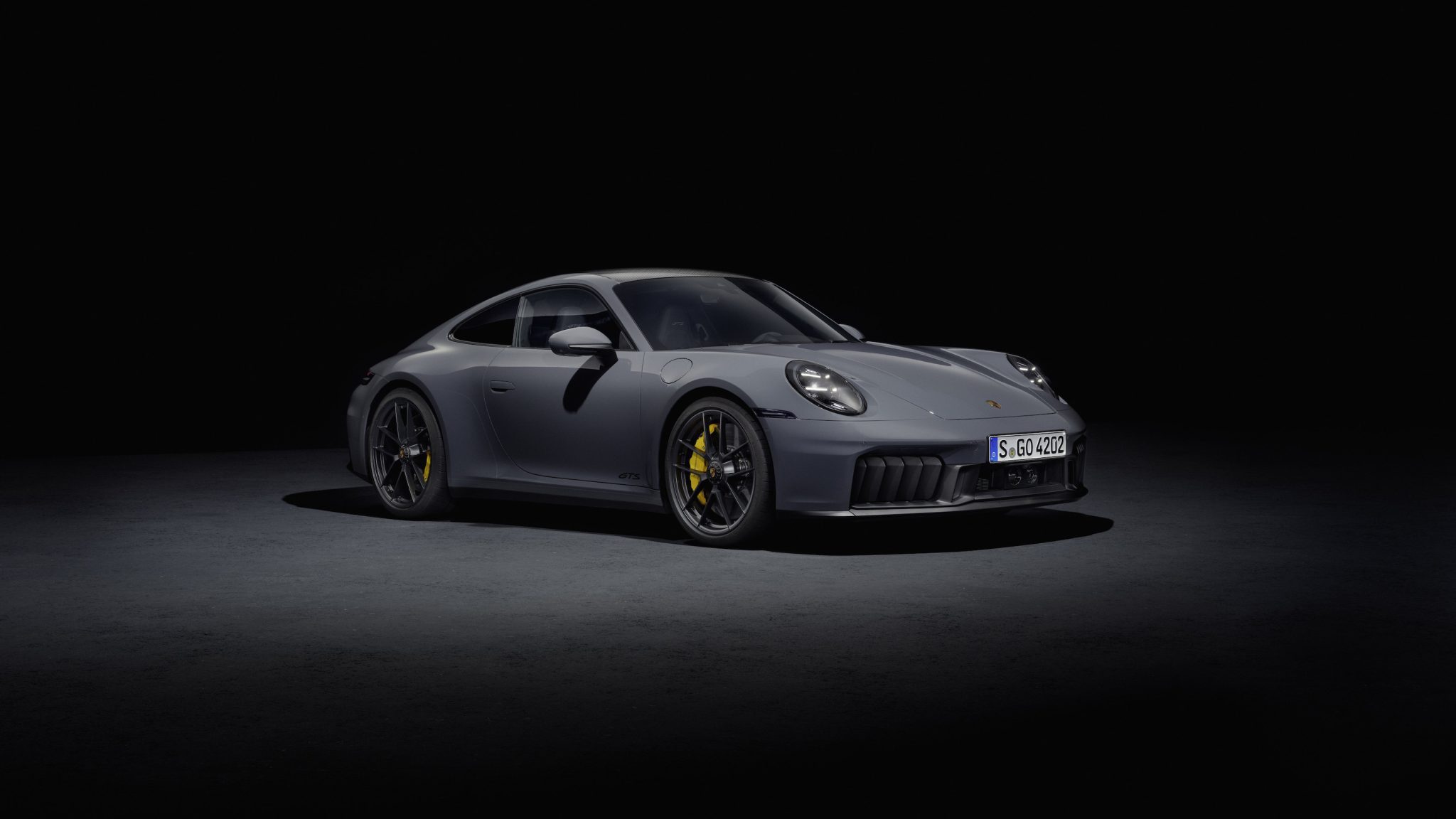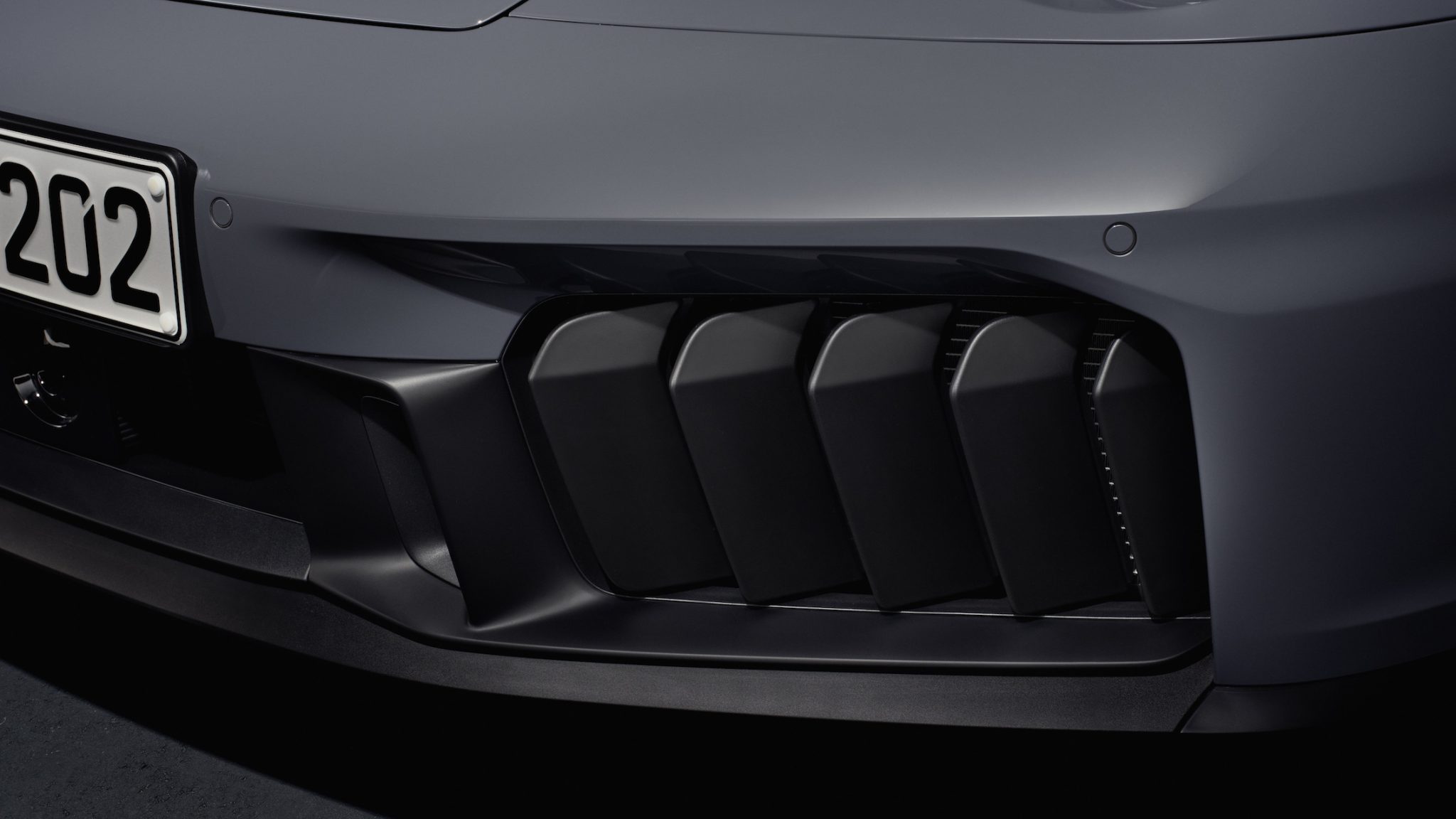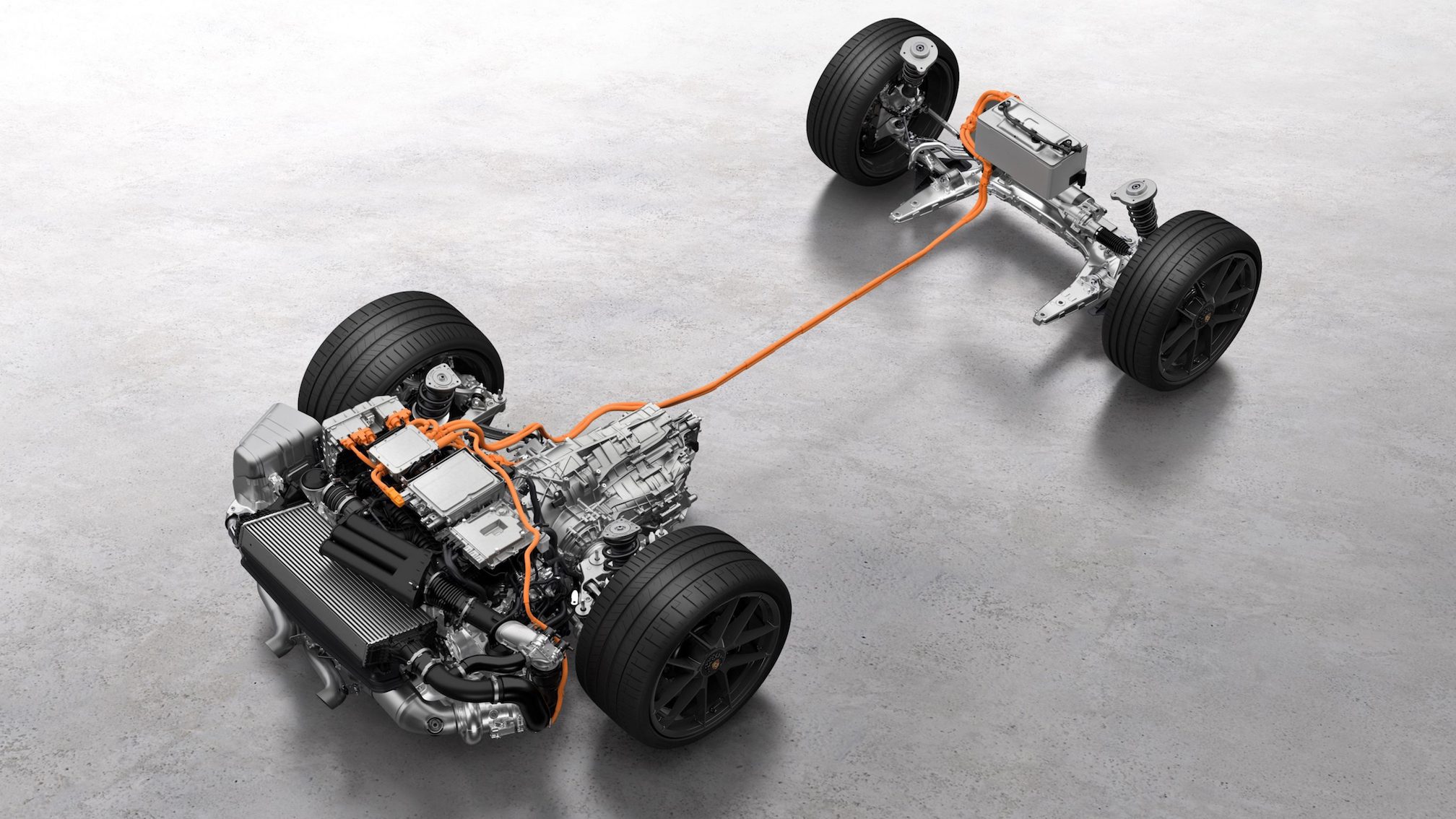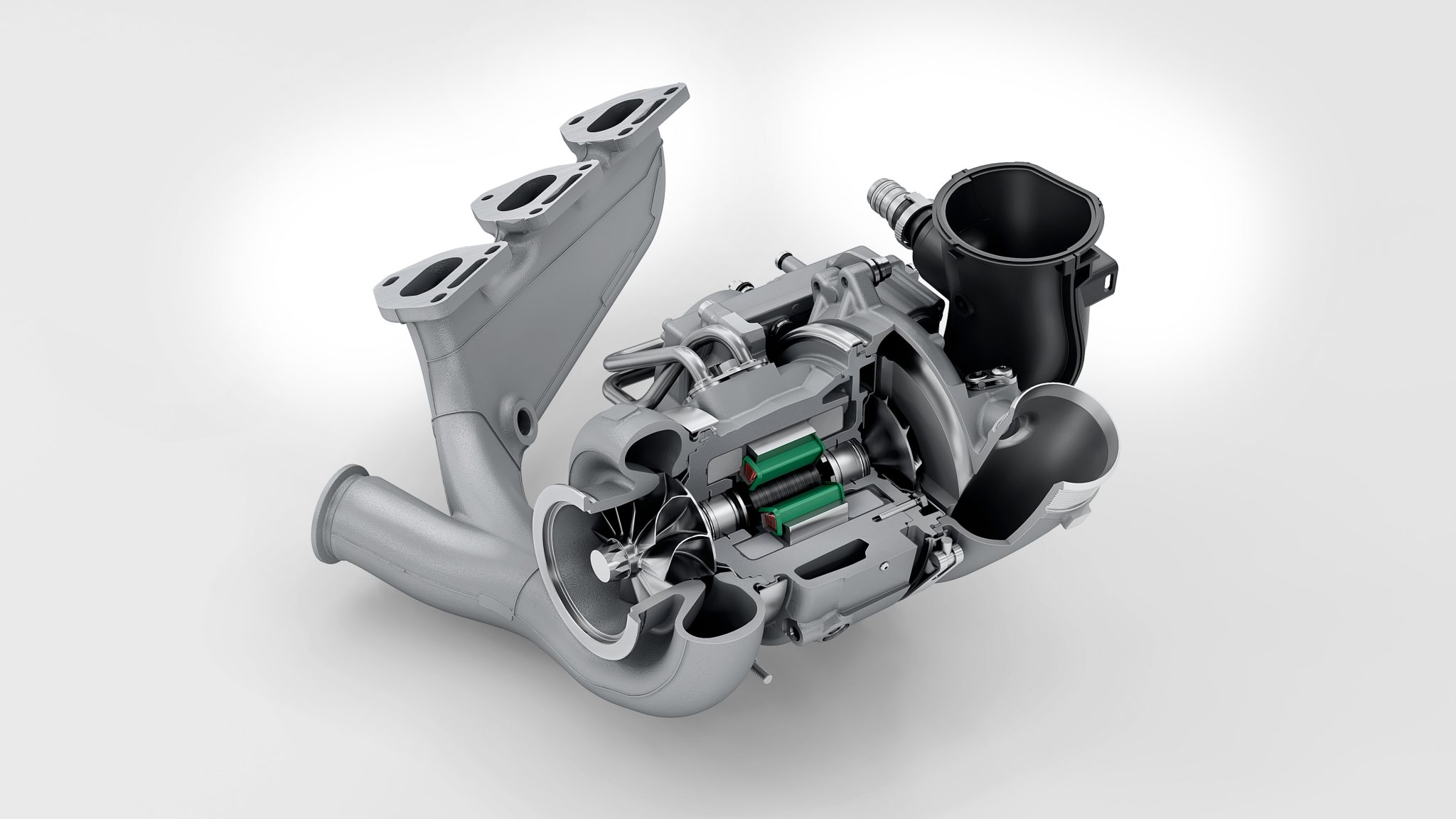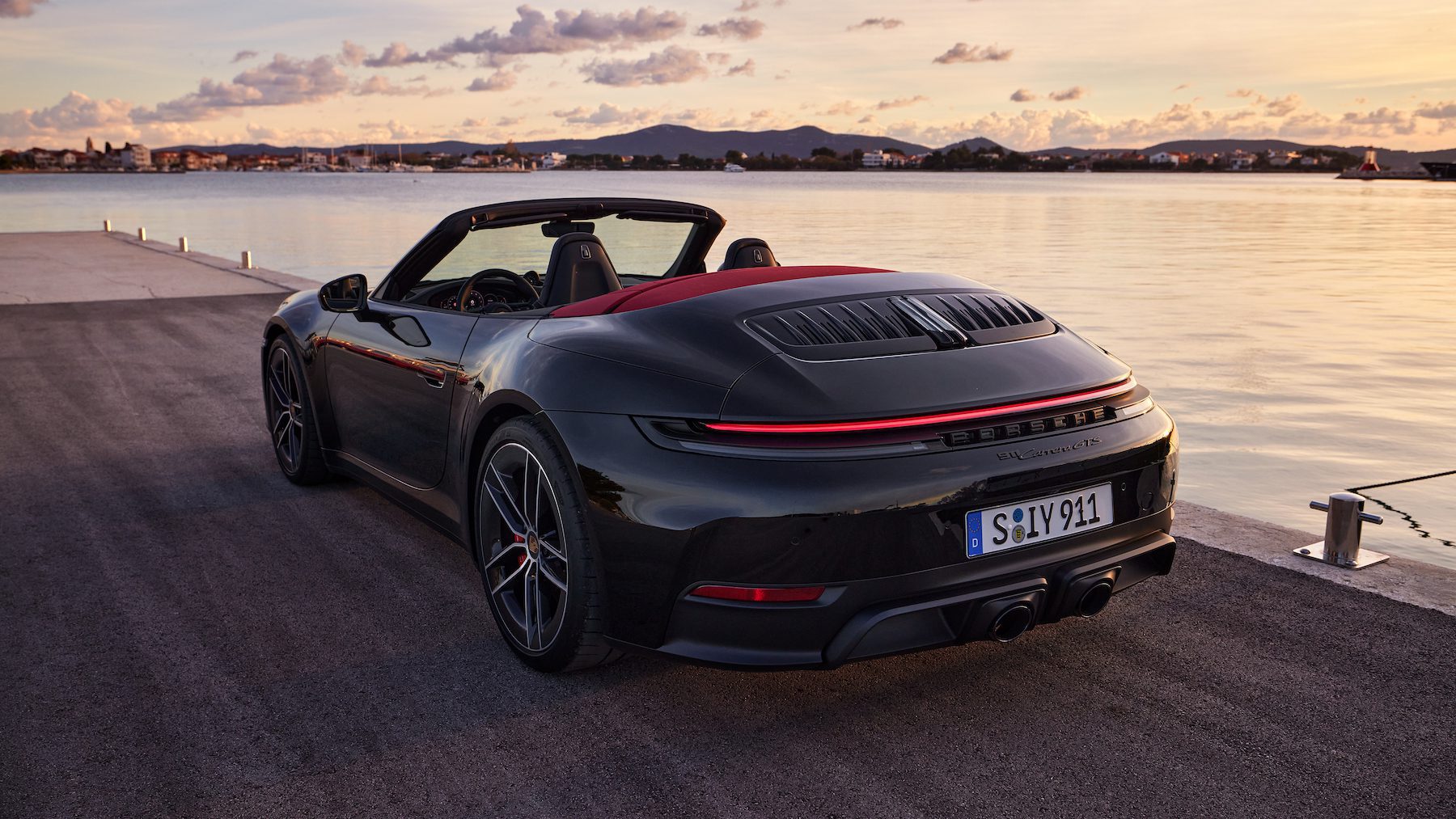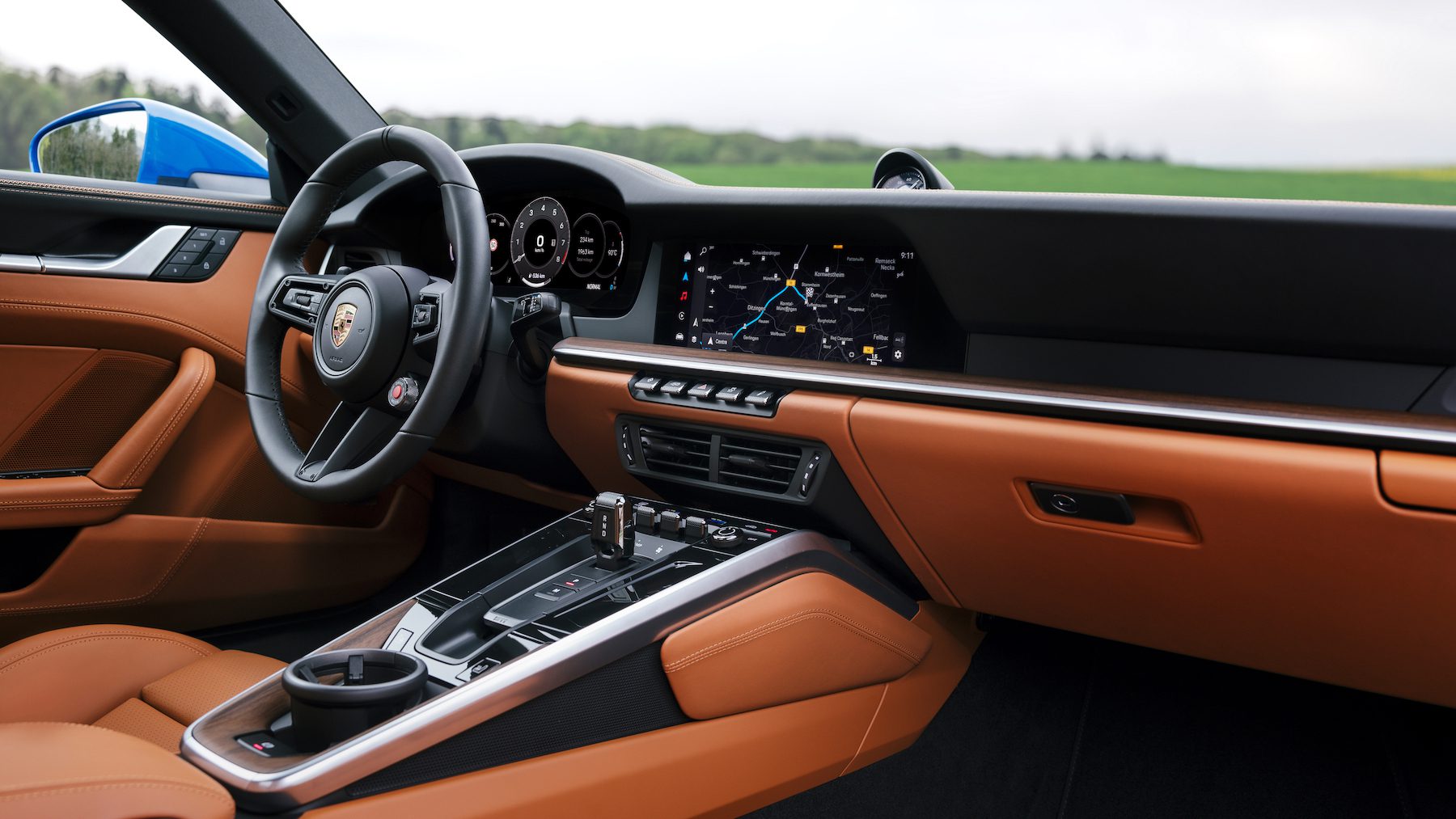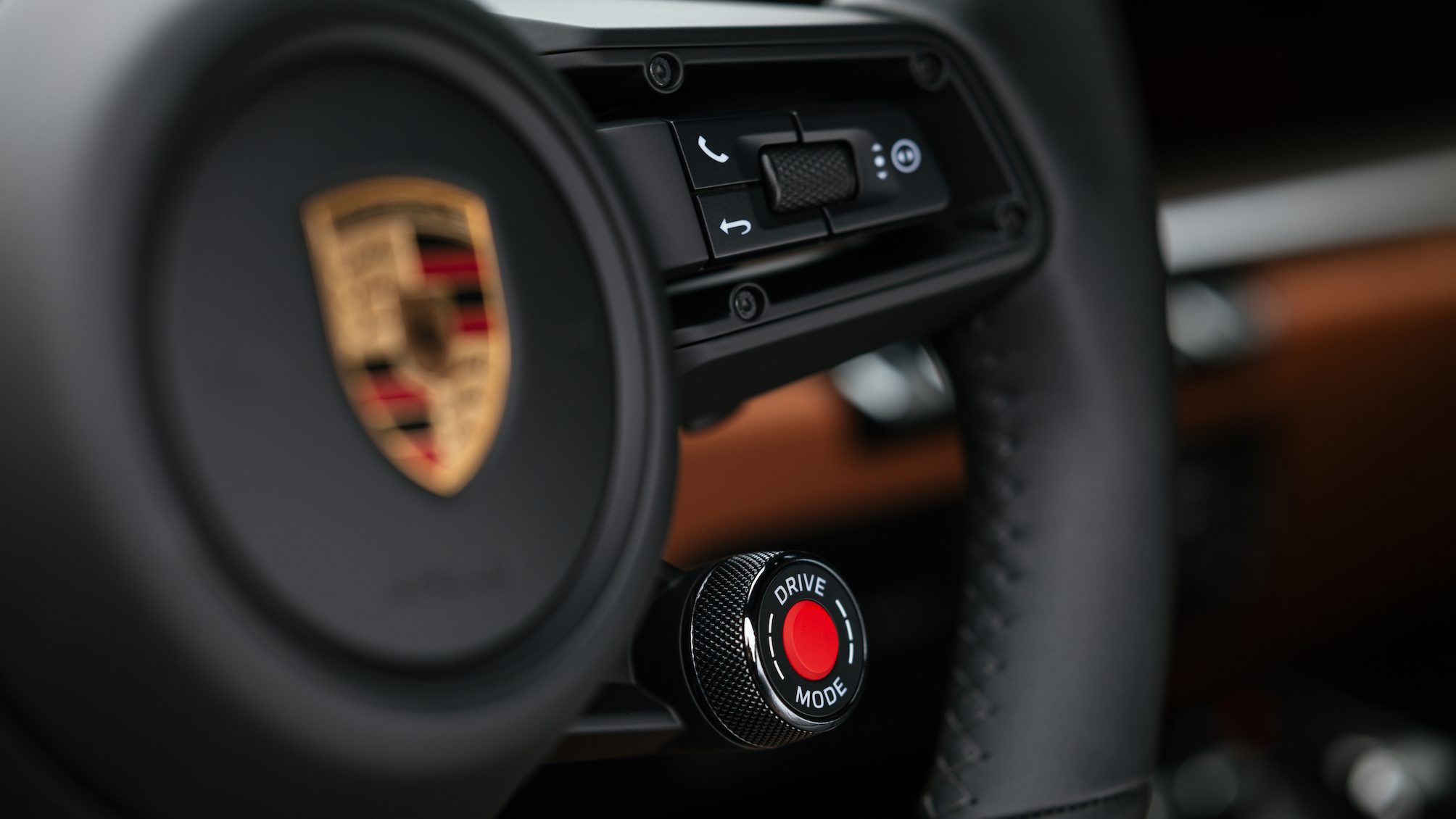‘The greatest difference with this car is just how easy it is to balance. You really don’t have to think about it, because the response is always instant and exactly what you expect.’
Credit: Newroom Porsche
Were this the observation of a public relations spokesperson in a press conference, I might have taken the comment with a fistful of salt. But this is no press man and this is no press conference. It’s veteran Porsche racer Joerg Bergmeister – class winner at both Daytona and Le Mans and winner outright of the Spa 24 Hours – and right now we’re sideways, power on, steaming towards the exit of turn one at the Weissach test track, a corner approached at 160mph. He’s grinning and chatting away, providing the most literal and vivid illustration imaginable of the point he is trying to make.
We are in the new Porsche 911, the second-generation 992, on sale now in base Carrera form (of which more further down the page) and in Carrera GTS guise, the once traditional season ender now turned curtain raiser. And whatever you read in all that’s to come, which I hope is interesting, it is worth remembering that what matters is less what it is, and more what it does, as Herr Bergmeister is doing his very best to demonstrate now.
Porsche 911 Carrera GTS Comparison
Porsche 911 Carrera GTS |
Gen 1 992 |
Gen 2 992 |
| Engine | 2981cc, 6-cyl, twin-turbo | 3591cc, 6-cyl, single turbo, hybrid |
| Transmission | 8-speed dual-clutch, RWD | 8-speed dual-clutch, RWD |
| Power | 473bhp | 533bhp |
| Torque | 420lb ft | 450lb ft |
| Weight | 1545kg (PDK) | 1595kg |
| Power to Weight | 306bhp/tonne | 334bhp/tonne |
| 0-62mph | 3.4sec (PDK), 4.1sec (manual) | 3.0sec (PDK only) |
| Top Speed | 193mph | 194mph |
| Price | £122,000 |
£132,600 |
A Skilled driver's perspective on performance
The problem is – and I’ve been here before, and it’s one of the reasons I resist almost all attempts to persuade me to tell a story from the passenger seat – Joerg is just too damn good a driver. Put a merely decent pedaller behind the wheel and it would be far easier to figure out how much of what you were witnessing was down to the car, and what proportion was due to its driver. But here’s a bloke who knows this car and track so well he can converse, make jokes and look at you while simultaneously balancing the throttle of a 533bhp car with 90 degrees of opposite lock applied. So you’ll be getting no definitive judgements from me today, and if you get them from anywhere else, they should be treated with the gravest suspicion.
The First Road-Going Hybrid 911
So I went along for this particular ride because I’ve known for a while that this car was going to be different. The new Carrera GTS is the first road-going hybrid 911 and just the second of any kind, the first being the pair of 997-based GT3R hybrid race cars built in 2010 and 2011 with a Williams-developed flywheel sat in a sealed carbon fibre box on the floor below where the passenger seat would have been.
But this is so much more than the current 992 with a bit of electrical assistance. Just for a start it has a brand new engine – not a single common part carried over – displacing 3.6 litres instead of the 3-litre unit in the outgoing GTS. More surprising still, it’s lost a turbocharger, a single unit about the size of a dustbin lid replacing the two smaller puffers used to date. That turbo is a kind of mini hybrid all by itself, insofar as it’s powered not just by exiting exhaust gases in the usual way, but by its own electric motor located between the compressor and turbine, capable of spinning the turbo up to speed so fast that throttle response, instead of being hindered by the additional inertia of the big turbo, is transformed for the better.
“Inevitably the car is heavier, but Porsche is at pains to point out that it has approached the challenge of hybridising the 911 with performance as its number one priority, so weight gain had to be minimised”
Credit: Newroom Porsche
A New Level of Speed and Acceleration
Entirely separate to that is another, far larger electric motor positioned between engine and gearbox and fed by a very compact battery located directly ahead of the passenger compartment and essentially on top of the fuel tank. Luggage space is unaffected.
The upshot? A car that responds so rapidly it’s quicker out of the blocks than a current 911 Turbo S and over a lap of the Nürburgring too. And while Porsche is saying precisely nothing about other forthcoming variants, you don’t develop an all-new engine with this kind of specification for just one car. Make no mistake: the GTS is the departure point for this new hybrid powertrain. So just imagine where it might go in a Turbo, a Turbo S, or even a GT2 RS…
For now, though, what we have is an engine with 533bhp, a 60bhp improvement over its predecessor. Torque rises from 420 to 450lb ft. Inevitably the car is heavier, but Porsche is at pains to point out that it has approached the challenge of hybridising the 911 with performance as its number one priority, so weight gain had to be minimised. To that end it says the single big electric turbo weighs no more than two of the old turbos and that the battery has been kept as small as possible (its capacity is just 1.9kWh) to keep mass to a minimum.
“Hybrid it may be, but a plug-in it most certainly is not. Its EV-only range is zero miles. On paper at least, its fuel consumption and CO2 figures will better those of the current GTS by the smallest of fractions, or not at all: final homologation is not yet complete”
Credit: Newroom Porsche
Focus on Weight Minimization and Hybrid Integration
This has kept the total claimed weight gain to 50kg. There is however just a puff of smoke and mirrors here, Porsche now selling the car as a two-seater as standard, with rear seats added as a no cost option which means they don’t have to be included in the car’s declared DIN weight. The seats weigh 10kg, so the like for like increase is actually 60kg, that mass including the four-wheel steer system that has now been made standard in the GTS. Targas and Cabriolet versions are 2+2 only. Why bother for just 10kg? It keeps the car’s DIN kerbweight under 1600kg, that’s why.
A few things in need of pointing out. First, hybrid it may be, but a plug-in it most certainly is not. Its EV-only range is zero miles. On paper at least, its fuel consumption and CO2 figures will better those of the current GTS by the smallest of fractions, or not at all: final homologation is not yet complete. So this is no tax break special as good at reducing running costs as 0-60mph times. Then again, producing meaningful extra power for no penalty at the pumps is an achievement, particularly given the way that power is delivered.
In a traffic light Grand Prix – without using launch control but just accelerating away – it will pull out a seven metre lead over the outgoing GTS in just 2.5 seconds, attributable in small part to the power, but mainly the instantaneous response. Bergmeister was kind enough to prove this precise point to me, blasting off the line when I wasn’t expecting it at a rate of knots that made me feel slightly sick.
Eliminating Turbo Lag and Boosting Power Output
Even so, it does rather beg the question: why do it? Why go to all that effort designing a new engine, a hybrid system, an electrically driven turbo when the same power and torque could have doubtless been delivered by turning up the wick on the old engine?
There are two declared reasons: first is the new engine’s ability to eliminate turbo-lag, second it means the engine can meet all current and known future emissions standards. Fair enough, but it’s also worth considering the wriggle room the new engine now provides. Consider that the new engine (for now anyway) actually produces a lot less horsepower per litre than the old: 478bhp before the additional hybrid power is included.
This provides a specific output of 133bhp per litre, while the smaller, older engine made 473bhp, a specific output of 159bhp per litre. If all Porsche did was put its new engine in the same state of tune as the old, that would deliver 572bhp before the addition of the hybrid, rising to 625bhp once the electrics had been attached in their current form. Which is getting damn near the current Turbo S output.
Credit: Newroom Porsche
Potential of Porsche’s 911 Hybrid Powertrain
Let us take that one step further: clearly both the petrol and electric motors have considerably more development potential than that, so it really isn’t much of a leap at all to see a new 911 Turbo or Turbo S with a power output far beyond 700bhp especially if – and I confess I am speculating now, but not entirely without reason or justification – Porsche built a twin electric turbo version of its new engine. I mention it now because I spoke to two Porsche engineers at different times and both gave me a wry grin before saying that, yes, huge power increases would then be possible, but that we’d have to wait and see…
Porsche, of course, isn’t saying even when or if those cars are coming – let alone how they’re powered – though clearly they are. But it is interesting too to look elsewhere in the range to see how it might fill out, and with what. The base Carrera we know about already: it keeps the old twin-turbo 3-litre motor, has no hybrid drive but gains another 10bhp. And following current thinking, it will be PDK only. Now, and this is important, the inclusion of the electric motor in the gearbox of the GTS means it is not possible for hybrid versions of the new 911 to be hooked up to manual gearboxes, so the current three-pedal GTS is the last.
But does that doom the manual 911 full stop? Again Porsche isn’t saying, but does freely admit that it has a small but very loyal cadre of customers who adore their manual transmissions and wouldn’t choose to be parted therefrom. Half of all GTS customers in the US currently choose a stick shift and Porsche will not want to be abandoning them. From which I conclude manual 911s will remain somewhere in the mix, from which I further conclude that they can only then be fitted to forthcoming Carrera S and Carrera T models and that, further still, these 911s must continue to use the old non-hybrid engine.
Credit: Newroom Porsche
“The easiest way to tell a second-gen 992 from its sire is to spot the five vertical vanes in the bottom of the front bumper which lend the car a somewhat toothy countenance. By incorporating the indicators into the headlamps, this space has been given over to air management”
It may be that I’m overstretching my sleuthing skills here, but that’s my best and not entirely uneducated guess. What does this all mean for the second-generation 992 GT3? My understanding is that it will continue to go its own way, eschewing hybrid and retaining the option of manual gears for as long as legislation allows. Just don’t expect any more power: its 4-litre motor is already absolutely on the limit of what can be achieved from both a homologation and durability point of view.
There are other changes for this latest generation of the world’s most enduring sports car. Visually the easiest way to tell a second-gen 992 from its sire is to spot the five vertical vanes in the bottom of the front bumper which lend the car a somewhat toothy countenance. By incorporating the indicators into the headlamps, this space has now been given over to air management, either to reduce drag under low levels of load, or increase cooling at maximum attack. Inside the dash has gone completely digital and the dials moved closer together so they can all be seen through the wheel.
Enhanced Suspension and Rear-Wheel Performance
In the suspension, if active roll bars are chosen these are now run off the same 400V system as the hybrid and are consequently far quicker to react. The rear tyre width has grown by two sections too, requiring a monster 315/30 boot, and such is the traction it now delivers, the lighter weight of the rear-drive GTS now offsets the additional longitudinal grip of the all-wheel drive car, meaning for the first time since front drive shafts became available on a 911, the rear-wheel drive model is now quicker off the line than the four-wheel drive machine.
I’ll close with a few more thoughts from the passenger seat, the first and least illuminating being how much I loathe being a passenger. I can tell you Bergmeister has god-like car control but I’m guessing you knew that already. The new engine doesn’t sound very different to the old but from what I can divine from his requests for more power and its arrival, it really does have the throttle response of a naturally aspirated engine. And the ease with which he drifts it about really is ridiculous.
Porsche 911 Hybrid Price and Value
While Joerg is both a world-class driver and a Porsche ambassador paid to make its cars look as good as possible, when he says that, to him, the key point about the new engine is the way it allows the car to be balanced on the limit, I don’t think he’s lying. But I did ask him to slow on the straight, select the highest gear the engine would accept and plant the throttle and, even from my unenviable vantage point, the instant slug of torque from the e-motor and electrically spun up turbo was obvious.
I think we’ll leave it there, at least until I can swap seats and tell you what it’s really like to drive. But the only immediately obvious downside has nothing to do with the car or its engineering, but its price. While the base Carrera price rises a rather modest £2800 to £99,800 (presumably so there can remain at least one 911 with a nominal five-figure price tag), the cost of the GTS rises £10,600 to £132,600. But that’s still over £23,000 less than a Turbo (let alone a Turbo S) and given it’s at least as quick in the real world, perhaps it’s something of a bargain?
Hopefully I’ll be able to let you know in a few weeks’ time.
Credit: Newroom Porsche

